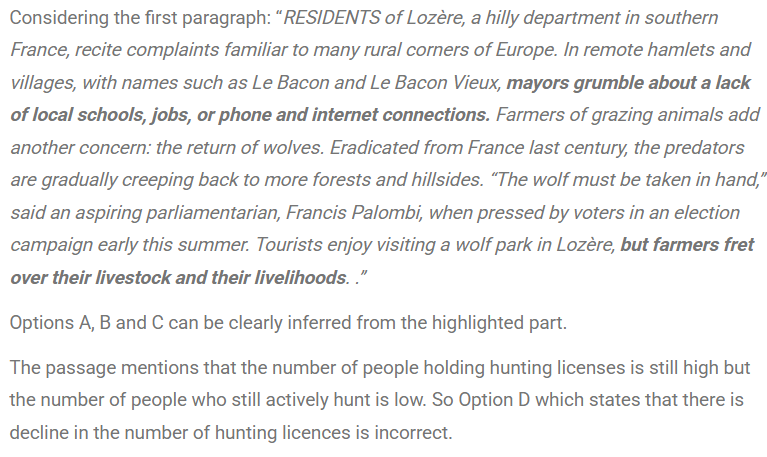CAT RC Questions | CAT RC- Social Science questions
FundaMakers is the Best CAT Online Coaching In India. Now prepare for CAT anytime with FundaMakers. We provide well-ordered syllabus coverage for both offline and online CAT preparation batches. FundaMakers brings to you the power-packed, well-structured CAT previous year question bank with more than 4000+ CAT Past Year questions. In the VARC section, one of the most frequently asked questions is from the topic- Reading Comprehension. Reading Comprehension turns out to be an important part of the VARC section from which over 60-70% of the questions are based on RC in the CAT Exam.
FundaMakers as a team has taken a painstaking step to bring you all the video solutions of the Reading Comprehension asked in the Previous Year CAT exam. CAT question bank offered by FundaMakers is a power-packed topic-wise compilation of the entire CAT previous year questions. Questions from the Reading Comprehension topic are some of the most scoring questions in the VARC section. To maximize your CAT score make use of FundaMakers CAT Question Bank. “Questions from CAT previous years” examination papers have been incorporated. Let’s get started with CAT Past Year Reading Comprehension Questions.
Comprehension
Directions for the questions: The passage below is accompanied by a set of questions. Choose the best answer to each question.
RESIDENTS of Lozère, a hilly department in southern France, recite complaints familiar to many rural corners of Europe. In remote hamlets and villages, with names such as Le Bacon and Le Bacon Vieux, mayors grumble about a lack of local schools, jobs, or phone and internet connections. Farmers of grazing animals add another concern: the return of wolves. Eradicated from France last century, the predators are gradually creeping back to more forests and hillsides. “The wolf must be taken in hand,” said an aspiring parliamentarian, Francis Palombi, when pressed by voters in an election campaign early this summer. Tourists enjoy visiting a wolf park in Lozère, but farmers fret over their livestock and their livelihoods. . . .
As early as the ninth century, the royal office of the Luparii—wolf-catchers—was created in France to tackle the predators. Those official hunters (and others) completed their job in the 1930s, when the last wolf disappeared from the mainland. Active hunting and improved technology such as rifles in the 19th century, plus the use of poison such as strychnine later on, caused the population collapse. But in the early 1990s the animals reappeared. They crossed the Alps from Italy, upsetting sheep farmers on the French side of the border. Wolves have since spread to areas such as Lozère, delighting environmentalists, who see the predators’ presence as a sign of wider ecological health. Farmers, who say the wolves cause the deaths of thousands of sheep and other grazing animals, are less cheerful. They grumble that green activists and politically correct urban types have allowed the return of an old enemy.
Various factors explain the changes of the past few decades. Rural depopulation is part of the story. In Lozère, for example, farming and a once-flourishing mining industry supported a population of over 140,000 residents in the mid-19th century. Today the department has fewer than 80,000 people, many in its towns. As humans withdraw, forests are expanding. In France, between 1990 and 2015, forest cover increased by an average of 102,000 hectares each year, as more fields were given over to trees. Now, nearly one-third of mainland France is covered by woodland of some sort. The decline of hunting as a sport also means more forests fall quiet. In the mid-to-late 20th century over 2m hunters regularly spent winter weekends tramping in woodland, seeking boars, birds and other prey. Today the Fédération Nationale des Chasseurs, the national body, claims 1.1m people hold hunting licences, though the number of active hunters is probably lower. The mostly protected status of the wolf in Europe—hunting them is now forbidden, other than when occasional culls are sanctioned by the state—plus the efforts of NGOs to track and count the animals, also contribute to the recovery of wolf populations.
As the lupine population of Europe spreads westwards, with occasional reports of wolves seen closer to urban areas, expect to hear of more clashes between farmers and those who celebrate the predators’ return. Farmers’ losses are real, but are not the only economic story. Tourist venues, such as parks where wolves are kept and the animals’ spread is discussed, also generate income and jobs in rural areas.
CAT/2023.1
Question . 69
The inhabitants of Lozère have to grapple with all of the following problems, EXCEPT:
Explanatory Answer
Method of solving this CAT RC Question from RC- Social Science question
Correct Option: D

Hey!
Worried about IIM calls due to your marks in 10th,12th, and Graduation?
Don't worry! Know your chances of getting an IIM Call based on your profile with our:-
Profile Professor: https://fundamakers.com/profile-professor/

5 Must- NOT-Dos during CAT Preparation.
- Do not treat CAT as 'Everything'.
- Do not quit your job for CAT exam preparation.
- Learning till The Eleventh hour instead of doing proper revision.
- Not checking the syllabus thoroughly.
- Piling up multiple books.
Click To Read:- Common mistakes made by CAT aspirants during preparation.
FundaMakers- Best Online and Offline CAT Online Preparation Institute in India
For any CAT Preparation related query, reach out to us at 9598333344.